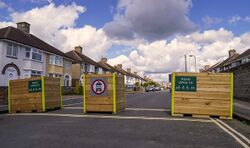Low Traffic Neighbourhood
(Population control, Urban planning) | |
|---|---|
 Using planters to block roads | |
| A top-down scheme implemented to reduce through-traffic in residential areas through the use of filtered permeability and traffic calming. |
Low Traffic Neighbourhoods or LTNs are a keystone of the "15-minute city". During COVID-19, local councils seeked to use the crisis as an excuse to introduce car free measures like block roads under the guise of promoting healthy living, reducing traffic congestion, lowering air pollution and preventing climate change.[1] In the beginning LTNs were used to enforce the COVID-19/Lockdown on the local level.[2]
Starting in London, they have now spread to other towns and cities across Britain. LTNs have been introduced with zero consultation with residents.[3]
In November 2020, The Guardian published an article promoting the concept, denying that they "disproportionately benefit better-off households".[4]
Official narrative
According to Wikipedia[5], "A Low Traffic Neighbourhood (LTN) is a scheme implemented to reduce through traffic in residential areas through the use of filtered permeability and traffic calming.
LTNs can be implemented through the use of barriers such as bollards, boom barriers and planters, though can also be implemented virtually through the use of automatic number-plate recognition cameras and road signs, which can allow residential motor access while prohibiting passing motor traffic.
There is evidence to show that LTNs lead to a decrease in car use, increase in walking and cycling and a decrease in street crime, violent crime and sexual assault."
References
- ↑ https://www.bbc.co.uk/news/uk-england-london-54180647
- ↑ https://www.local.gov.uk/local-authority-covid-19-compliance-and-enforcement-good-practice-framework
- ↑ https://www.onlondon.co.uk/introducing-low-traffic-neighbourhoods-without-prior-consultation-was-a-mistake-says-labour-london-politician/
- ↑ https://www.theguardian.com/environment/2020/nov/16/claim-low-traffic-schemes-only-benefit-better-off-debunked-in-new-study
- ↑ https://en.wikipedia.org/w/index.php?title=Low_Traffic_Neighbourhood&oldid=1139686026